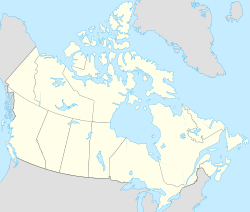Pangnirtung, Nunavut
|
Pangnirtung Pangniqtuuq ᐸᖕᓂᖅᑑᖅ |
|
|---|---|

"Uptown" neighbourhood of Pangnirtung. April 2006
|
|
| Nickname(s): Pang | |
| Coordinates: 66°08′52″N 065°41′58″W / 66.14778°N 65.69944°WCoordinates: 66°08′52″N 065°41′58″W / 66.14778°N 65.69944°W | |
| Country | Canada |
| Territory | Nunavut |
| Region | Qikiqtaaluk Region |
| Electoral district | Pangnirtung |
| Government | |
| • Type | Hamlet Council |
| • Mayor | Mosesee Qappik |
| • MLAs | Johnny Mike |
| Area | |
| • Land | 7.77 km2 (3.00 sq mi) |
| Elevation | 23 m (75 ft) |
| Population (2016) | |
| • Total | 1,481 |
| • Density | 190.6/km2 (494/sq mi) |
| Time zone | EST (UTC-5) |
| • Summer (DST) | EDT (UTC-4) |
| Canadian Postal code | X0A 0R0 |
| Area code(s) | 867 |
| Website | www |
Pangnirtung (or Pang, also Pangniqtuuq, in syllabics: ᐸᖕᓂᖅᑑᖅ IPA: [paŋniqtuːq]) is an Inuit hamlet, Qikiqtaaluk Region, in the Canadian territory of Nunavut, located on Baffin Island. As of the 2016 census the population was 1,481, an increase of 3.9% from the 2011 census. The area of the town is 7.77 km2 (3.00 sq mi). Pangnirtung is situated on a coastal plain at the coast of Pangnirtung Fjord, a fjord which eventually merges with Cumberland Sound. As of January 2014, the mayor is Mosesee Qappik.
There is some confusion about the village name. Residents say the real name is Panniqtuuq, which means "the place of many bull caribou". Early in 2005 residents voted against officially changing the name of the village to the native one, as Pangnirtung has achieved an international reputation. Its residents have created high-quality traditional arts in sculpture, as well as adaptation of themes and design in printmaking and weaving.
Pangnirtung is nicknamed the Switzerland of the Arctic, or simply Pang.
The Inuit and their ancestors have inhabited the area for thousands of years, perhaps as long as 4,000. Their cultures became well-adapted to the climate and environment.
Contact with European Canadians has been limited to less than the last century. In 1921, the Hudson's Bay Company established a trading post in Pangnirtung. Two years later, the Royal Canadian Mounted Police erected a permanent office. The first government-appointed teacher arrived in 1956. The first administrative office was established in 1962.
...
Wikipedia


